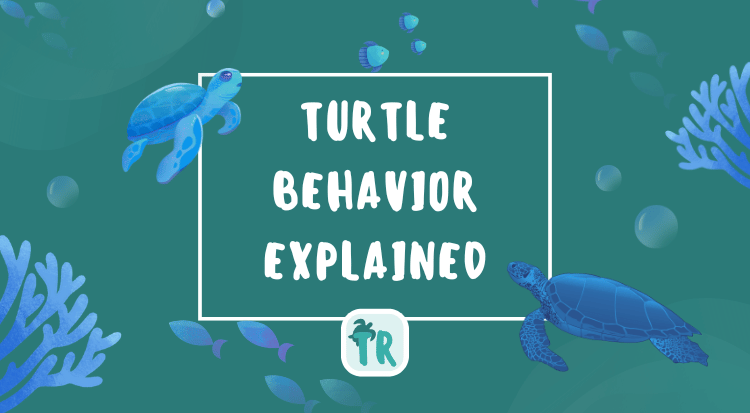Turtle Behavior Explained in Simple Language

Understanding your turtle's behavior is not just a matter of curiosity but a key to providing better care and strengthening your bond with your pet. Turtles have unique habits and ways of interacting with their environment.
This guide will explore common turtle behaviors, including social interactions, basking habits, and territorial actions. We'll also explore hibernation, nesting, and turtle communication.
Mastering these behaviors will give you insights into your turtle's needs and how to make them feel comfortable and happy, making you a more knowledgeable and competent pet owner.
Social Behaviors
Turtles have different ways of interacting with each other and other animals. Understanding their social behaviors is not just about observing but managing multiple turtles and understanding their actions.
Interaction with Other Turtles
Some turtles enjoy the company of others, while some prefer to be alone.
- Solitary Species: Many turtles are solitary and may become stressed when kept with others.
- Social Species: Some species, like Red-Eared Sliders, can live peacefully in groups if given enough space.
Signs of Aggression
Understanding aggressive behaviors is about knowing your turtle and preventing fights and injuries. It's a crucial part of responsible pet ownership.
- Biting and Nipping: Turtles may bite to show dominance or defend territory.
- Chasing: One turtle chasing another can be a sign of aggression.
- Mounting: This can be a sign of dominance or mating behavior.
Managing Social Interactions
As a responsible pet owner, if you keep more than one turtle, it's crucial to take steps to ensure they get along. Your role in managing their social interactions is key to their well-being and harmony.
- Provide Space: Make sure the habitat is large enough for all turtles.
- Separate if Necessary: If aggression occurs, consider housing turtles separately.
Hibernation and Brumation
Some turtles go through periods of inactivity during colder months. This natural behavior is called hibernation or brumation.
What Is Brumation?
Brumation is similar to hibernation but occurs in reptiles.
- Inactivity: Turtles become less active and may stop eating.
- Temperature Dependent: Triggered by cooler temperatures and shorter daylight hours.
Should Pet Turtles Brumate?
Not all pet turtles need to brumate, and it can be risky if not done properly.
- Consult a Vet: Get professional advice before allowing your turtle to brumate.
- Controlled Environment: If brumation is necessary, ensure safe temperatures and conditions.
Caring for a Brumating Turtle
If your turtle enters brumation, monitor its health carefully.
- Regular Checks: Gently check on your turtle without disturbing it too much.
- Maintain Proper Conditions: Keep the habitat at the right temperature and humidity.
Basking Habits
Basking is when turtles emerge from the water to dry off and absorb heat and UVB rays.
Why Do Turtles Bask?
Basking is essential for a turtle's health.
- Thermoregulation: Helps regulate body temperature.
- Shell Health: Drying off prevents shell infections.
- Vitamin D3 Production: UVB exposure aids in calcium absorption.
Observing Basking Behavior
Understanding how your turtle basks can tell you about its health.
- Frequency: Healthy turtles bask regularly throughout the day.
- Position: Turtles may stretch out their legs and neck to maximize exposure.
Encouraging Basking
Create an ideal basking area to support this behavior.
- Provide a Basking Spot: Use a platform or rock under a heat lamp.
- Ensure Accessibility: Make it easy for your turtle to climb onto the basking area.
Territorial Behavior
Turtles can be territorial, especially in confined spaces.
Signs of Territoriality
Recognizing territorial behaviors can help prevent conflicts.
- Aggression Towards Others: Biting or pushing other turtles away.
- Defending a Space: Staying in one area and not allowing others near.
Managing Territorial Behavior
Take steps to reduce territorial disputes.
- Provide Enough Space: A more extensive habitat reduces competition.
- Multiple Basking Areas: Offer more than one basking spot.
Nesting Behaviors
Female turtles have specific behaviors related to laying eggs.
Recognizing Nesting Behavior
Even without a male, female turtles may lay unfertilized eggs.
- Restlessness: Walking around the habitat, looking for a nesting spot.
- Digging: Attempting to dig in the substrate.
Providing a Nesting Area
If your female turtle shows nesting behaviors, it's a sign that she needs your care and consideration. Providing a suitable area for laying her eggs, such as a sandy or soil area for digging, and ensuring she has privacy in a quiet, undisturbed spot, will make her feel secure and cared for.
- Soft Substrate: Provide a sandy or soil area for digging.
- Privacy: A quiet, undisturbed spot helps your turtle feel secure.
Communication in Turtles
Turtles communicate in subtle ways.
Visual Signals
Turtles use body language to express themselves.
- Head Bobbing: May indicate aggression or courtship.
- Shell Tapping: Some species tap shells during mating rituals.
Vocalizations
While generally quiet, turtles can make sounds.
- Hissing: Often a sign of stress or fear.
- Grunting: This may occur during exertion or mating.
Scent Marking
Turtles may use scents to communicate.
- Releasing Pheromones: To attract mates or mark territory.
Conclusion
Understanding turtle behavior helps you provide the best care for your pet. By recognizing social interactions, basking habits, and other behaviors, you can create a comfortable environment that meets your turtle's needs.
Observing your turtle's actions can also alert you to any health issues. Enjoy learning about your turtle's unique personality and behaviors as you strengthen your bond.